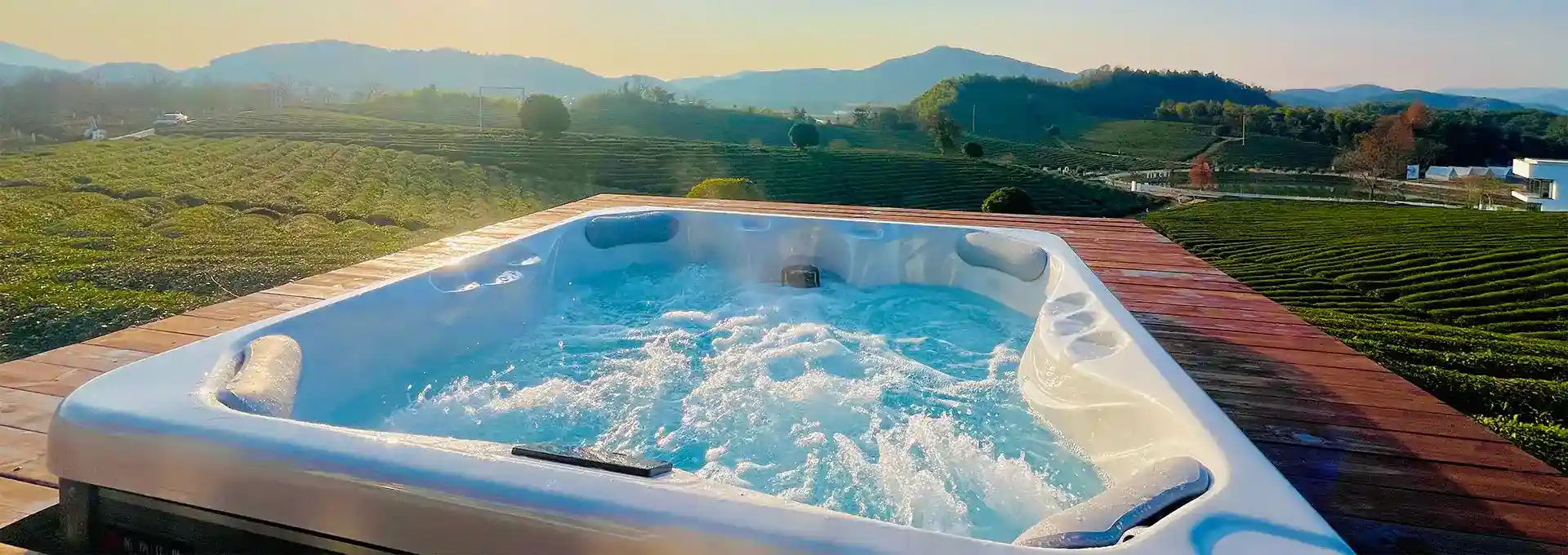What is a Swim Spa vs Hot Tub?
2024-08-29 17:48:05
When it comes to home water relaxation and exercise options, two popular choices often come to mind: swim spas and hot tubs. While both offer aquatic enjoyment, they serve different purposes and have distinct features. This article will explore the key differences between swim spas and hot tubs, helping you understand which option might be best suited for your needs and preferences.
What are the benefits of a hot tub swim spa combo?
A hot tub swim spa combo, also known as a dual-zone swim spa, combines the best of both worlds: a swim spa for exercise and a hot tub for relaxation. This innovative design offers numerous benefits that make it an attractive option for homeowners looking to maximize their investment in aquatic fitness and leisure.
One of the primary advantages of a hot tub swim spa combo is its versatility. The swim spa section provides a continuous current for swimming, water jogging, or aquatic exercises, allowing users to engage in low-impact cardiovascular workouts without the need for a full-sized swimming pool. This feature is particularly beneficial for those with limited outdoor space or those who want to swim year-round without the maintenance challenges of a traditional pool.
On the other hand, the hot tub section offers a dedicated space for relaxation and hydrotherapy. After a vigorous swim or workout, users can seamlessly transition to the hot tub area to soothe tired muscles and unwind. The combination of warm water, powerful jets, and ergonomic seating provides an excellent environment for stress relief, muscle recovery, and overall well-being.
Another significant benefit of a hot tub swim spa combo is its energy efficiency. By combining two separate water features into one unit, you can reduce overall energy consumption compared to maintaining a separate pool and hot tub. Many models come with advanced insulation and energy-saving features, helping to keep operating costs down while still providing year-round enjoyment.
The dual-zone design also offers flexibility in terms of water temperature. While the swim spa section can be kept at a cooler temperature ideal for exercise, the hot tub area can be maintained at a higher temperature for relaxation. This allows multiple users to enjoy the combo simultaneously, catering to different preferences and needs.
For families or households with diverse interests, a hot tub swim spa combo can be an excellent investment. It provides a space for fitness enthusiasts to train, children to play and learn to swim, and adults to relax and socialize. This multi-functionality can enhance the overall value of your property and create a focal point for outdoor entertainment.
Maintenance-wise, a hot tub swim spa combo can be more manageable than separate units. With a single filtration and sanitation system, you can streamline the upkeep process, saving time and effort in the long run. Many modern combos also feature advanced water purification technologies, ensuring clean and safe water with minimal chemical use.
Lastly, the aesthetic appeal of a hot tub swim spa combo cannot be overlooked. These units often come in sleek, modern designs that can complement various outdoor landscapes. Whether installed in-ground or above-ground, a combo can serve as an attractive centerpiece for your backyard oasis, enhancing the overall ambiance and potentially increasing your property value.
How does the cost of a swim spa compare to a traditional pool?
When considering aquatic options for your home, cost is often a significant factor in the decision-making process. Comparing the cost of a swim spa to a traditional pool involves several aspects, including initial installation, ongoing maintenance, and long-term value.
Initial installation costs for a swim spa are generally lower than those for a traditional pool. Swim spas are pre-fabricated units that can be installed above ground or partially in-ground, requiring less excavation and construction work compared to a traditional pool. This can result in significant savings on labor and materials. Additionally, swim spas typically have a smaller footprint, which means less disruption to your existing landscape and potentially lower costs for site preparation.
The average cost of a high-quality swim spa ranges from $20,000 to $50,000, depending on size, features, and brand. In contrast, a traditional in-ground pool can cost anywhere from $35,000 to $100,000 or more, especially when factoring in additional features like decking, lighting, and landscaping. This substantial difference in upfront costs makes swim spas an attractive option for homeowners working with a more modest budget.
Ongoing maintenance costs also tend to favor swim spas. Due to their smaller water volume, swim spas require less water, fewer chemicals, and less energy to operate compared to traditional pools. The self-contained nature of swim spas also means that they're easier to clean and maintain, potentially reducing the need for professional pool services. Many swim spa owners find that they can handle routine maintenance themselves, further lowering ongoing costs.
Energy efficiency is another area where swim spas often outperform traditional pools. Modern swim spas are designed with advanced insulation and energy-saving features, such as high-efficiency pumps and LED lighting. These features, combined with the smaller water volume, result in lower heating and electricity costs. In colder climates, where a traditional pool might only be usable for a few months of the year, a well-insulated hot tub swim spa combo can provide year-round enjoyment without exorbitant heating bills.
When it comes to long-term value, swim spas can be a wise investment. Their compact size and potential for year-round use make them appealing to a wide range of homeowners, potentially increasing your property value. Additionally, if you decide to move, many swim spa models can be relocated, allowing you to take your investment with you – an option not available with traditional in-ground pools.
However, it's important to note that while swim spas offer many cost advantages, they may not fully replace the experience of a large traditional pool for some users. If you're looking for a spacious area for multiple swimmers or extensive water play, a traditional pool might still be the better choice despite the higher costs.
It's also worth considering the potential return on investment. While a well-designed traditional pool can add significant value to your home, the return on investment for a swim spa may be more variable depending on your local real estate market and the preferences of potential buyers.
Can you use a swim spa year-round?
One of the most appealing aspects of a swim spa is its potential for year-round use, making it a versatile investment for homeowners in various climates. However, the ability to use a swim spa throughout all seasons depends on several factors, including the spa's design, your local climate, and the measures you take to maintain and protect your investment.
Modern swim spas are engineered with year-round use in mind, especially in regions with varying seasonal temperatures. Many models come equipped with robust insulation systems that help maintain water temperature efficiently, even in colder months. This insulation, often consisting of multiple layers of high-density foam and reflective barriers, works to trap heat within the spa and prevent energy loss.
In addition to insulation, swim spas typically feature powerful heating systems capable of maintaining comfortable water temperatures even when outdoor temperatures drop. Some models even offer dual-temperature zones, allowing you to keep the swim area cooler for exercise while maintaining a warmer temperature in the hydrotherapy section.
For those living in colder climates, many swim spa manufacturers offer specialized winter kits or cold climate packages. These may include additional insulation, reinforced covers, and freeze protection systems to ensure your swim spa can withstand harsh winter conditions. Some advanced models also incorporate smart technology that monitors water temperature and automatically activates heating systems to prevent freezing.
Using a swim spa year-round in warmer climates is generally straightforward, as the main concern is keeping the water cool enough for comfortable swimming during hot summer months. Many swim spas come with built-in cooling systems or can be equipped with chillers to maintain ideal water temperatures even on the hottest days.
To maximize year-round usability, proper placement of your swim spa is crucial. Positioning it in a sheltered area, such as near a house wall or within a dedicated enclosure, can provide protection from harsh weather and help maintain more stable water temperatures. Some homeowners opt to install their swim spa in a sunroom or create a custom enclosure, allowing for a controlled environment that extends the usable season even further.
Regular maintenance is key to ensuring your swim spa remains operational throughout the year. This includes consistent water treatment, filter cleaning, and periodic checks of the spa's mechanical components. In colder months, it's especially important to monitor water chemistry and maintain proper water levels to prevent damage to the spa's systems.
Energy efficiency is another important consideration for year-round use. While swim spas are generally more energy-efficient than traditional pools, operating costs can still add up, especially in extreme temperatures. Investing in a high-quality, well-insulated cover can significantly reduce heat loss and energy consumption. Some swim spa owners also use solar blankets or liquid solar covers to further improve energy efficiency.
It's worth noting that while swim spas can be used year-round, the experience may vary depending on the season. In colder months, you might find yourself spending less time in the swim area and more time enjoying the hydrotherapy features. Conversely, in warmer months, the swim spa can serve as a refreshing oasis for exercise and relaxation.
For those considering year-round use, it's important to research swim spa models specifically designed for four-season enjoyment. Look for features like robust insulation, powerful heating systems, and warranties that cover year-round use in your climate. Consulting with local swim spa dealers or owners in your area can provide valuable insights into the practicalities of year-round use in your specific location.
In conclusion, swim spas offer a unique combination of exercise and relaxation features that set them apart from traditional hot tubs. Their versatility, energy efficiency, and potential for year-round use make them an attractive option for many homeowners. Whether you're looking for a space-saving alternative to a full-sized pool, a comprehensive fitness solution, or simply a way to enjoy aquatic relaxation throughout the year, a swim spa could be the perfect addition to your home. By carefully considering your needs, climate, and budget, you can determine if a swim spa is the right choice for you and your family.
If you want to get more information about this product, you can contact us at info@iparnassus.com!
References:
1. Swim University. (2021). "Swim Spas vs. Hot Tubs: Which One is Right for You?"
2. Aqua Magazine. (2020). "The Rise of the Swim Spa Market."
3. Pool and Spa News. (2022). "Comparing Costs: Swim Spas vs. Traditional Pools."
4. Hydropool Swim Spas. (2023). "Year-Round Use of Swim Spas: A Comprehensive Guide."
5. Endless Pools. (2021). "Energy Efficiency in Swim Spas: What You Need to Know."
6. Master Spas. (2022). "The Benefits of Hot Tub Swim Spa Combos."
7. Bullfrog Spas. (2023). "Maintenance Tips for Year-Round Swim Spa Use."
8. SwimEx. (2021). "Choosing the Right Swim Spa for Your Climate."
9. Aquatic Exercise Association. (2020). "Health Benefits of Aquatic Exercise in Swim Spas."
10. Home Advisor. (2023). "Average Cost of Installing a Swim Spa vs. In-Ground Pool."



